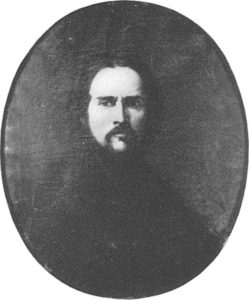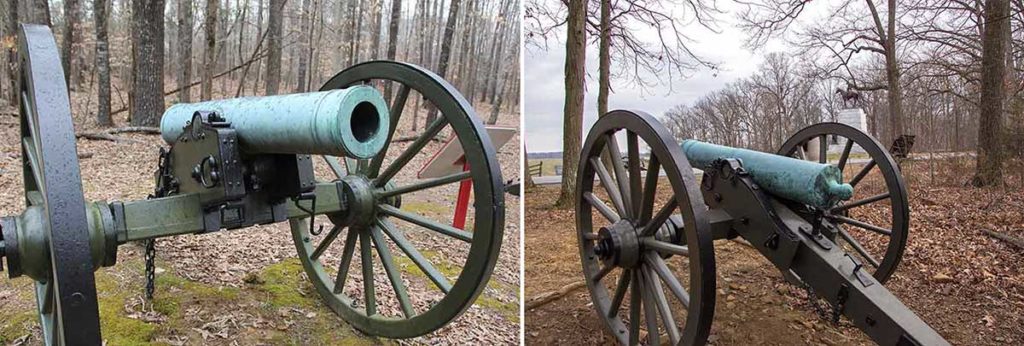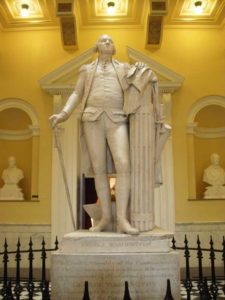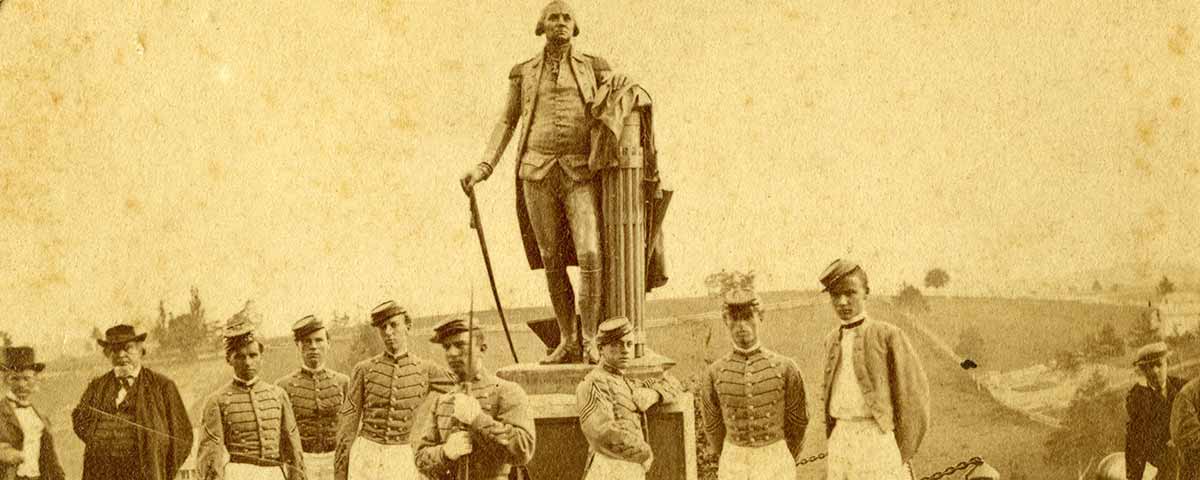That is the man himself,” the Marquis de Lafayette said as he viewed French sculptor Jean-Antoine Houdon’s statue of George Washington in 1824. “I can almost realize he is going to move.” The Commonwealth of Virginia had commissioned the statue in 1784 to be featured in the state’s capitol building, then under construction in Richmond. The 6-foot-tall marble sculpture is considered by many to be the best likeness of America’s first president. Erected in 1796, the statue stood in that same spot during the Civil War when the building served as the Confederate Capitol. Efforts to replicate the venerated artwork for other locations were interrupted by the war, when metal intended for statuary (bronze or another alloy) was diverted to making ordnance.

Washington after he moved to Richmond in the 1840s. (National Park Service)
In antebellum Virginia, Houdon’s statue became an obsession for American artist William James Hubard. Born in England in 1807, Hubard eventually moved to Boston and established a reputation as a portrait painter and silhouette artist. In the 1840s, he relocated to Richmond, where he happened upon Houdon’s statue of Washington. Recognizing the value of Houdon’s work and also fearing some disaster might damage or destroy the original, Hubard urged that bronze copies be produced.
In 1853, the Virginia General Assembly granted him such a license. Finding no facilities sufficient for his needs, Hubard built a new foundry outside Richmond, calling it the Washington Foundry. Hubard also secured ample quantities of bronze for anticipated orders. But despite those preparations, only a handful of orders arrived. Among six produced, the first went to Columbia, S.C., for a new state house then under construction. Hubard filled other orders from North Carolina and the Virginia Military Institute. Three other copies wound up in St. Louis; Miami, Ohio; and New York City.
The start of the Civil War found Hubard with a substantial stock of bronze and a well-provisioned foundry. With that in mind, on April 16, 1861, he sent a letter to Captain Charles Dimmock, chief of Virginia’s Ordnance Department, proposing “I will forth-with make two sample guns which shall be put to the most severe test [emphasis in original],” and adding:
You know I am better prepared by practical experience for that class of arm and am willing to take any risk and I can make them quicker than you can obtain them from any other hands. I would not make them as mere commercial articles—aiming as I do none at expectation than the mere profit. The prices you can determine by those fixed—and I am not willing to demand the contingent enumeration suggested by the necessity of the times.
Dimmock responded positively to the offer, asking for bronze howitzers to fill state needs. In the absence of complete records, it is probable that Hubard delivered only a half-dozen of these guns under the Virginia contract.
Two surviving 12-pounder field howitzers display stamps attesting to Hubard’s work—one at Gettysburg National Military Park and another at Shiloh. Both examples display stamps on their trunnions stating “W.J.H.” and “W.F.” Those correspond, respectively, to William J. Hubard and Washington Foundry. The Gettysburg example has an additional mark of “State of VA,” alluding to the state orders, early in the war.
The surviving guns match closely the established prewar Model 1841 form used for U.S. Army field howitzers. This was a proven design, with plans and particulars easily obtained in Richmond. But though Hubard had facilities for casting the howitzers, he lacked the ability to bore out the guns and turn them (i.e., smooth the exterior). For that work, Hubard sub-contracted to the firm of Thomas Samson & James Pae; an additional stamp of “S&P” is visible below those of Hubard and the foundry.

On October 5, 1861, Hubard received a follow-up order for 10 howitzers from Colonel Josiah Gorgas, Confederate chief of ordnance. As was often the case with cannons, payment was based on the weight of the finished howitzer, set at 35 cents per pound. The contract also extended funds for Hubard to purchase a crane, ladle, flasks, and other equipment in order to expand production. Terms of the contract required they be delivered by November 20.
Once again, Hubard used the familiar Model 1841 pattern for the howitzers. In the early stages of the war, Confederate cannon-makers often selected well-known and proven patterns in an effort to expedite deliveries. While details of the newer, and more potent, 12-pounder Model 1857 Napoleon guns were available, those required more metal per unit. The Washington Foundry howitzer at Shiloh has a stamp indicating its barrel weight was 770 pounds when accepted. Napoleon gun barrels weighed about 1,230 pounds. Hubard could cast two howitzers with nearly the same amount of metal required for a Napoleon.
Hubard’s attentions were not confined to field artillery, however. In late November 1860, he offered advanced weapon designs and his services to South Carolina Governor William H. Gist. Not masking his sectional politics, he wrote:
I desire to submit for your examination certain important inventions in war arms, which have been reserved for the exclusive use of the South. They have not been patented, and not made public for the reason given to be implied in their having been held for southern advantage.
Hubard then gave general details of a breechloading rifle that “fires 30 shots at one loading and is reloaded in about the same time required to cap an ordinary gun.” He claimed the gun would work even if dropped in water. A carbine version could fire 60 shots in a minute. And Hubard also offered a pistol which was “light and discharges from 10 to 12 shots in rapid succession and can be reloaded in the process of firing by the left hand.” Certainly a formidable weapon, had it indeed been perfected.
For artillery, Hubard offered an improved shrapnel shell for use by field artillery. “The shell when loaded can be fired with the accuracy of a solid ball; 25 percent more bullets can be packed into this shell.” Hubard’s fuses would work under water. Furthermore, he stated, “[t]here is not the least risk in loading or handling the loaded shell in any possible way.”
Hubard claimed these inventions were developed over many years and had “long been in hand. But want of occasion and proper attention has prevented their publicity.” He cautioned, though, that work was needed to perfect these weapons before full use. “[Y]our state,” he noted, “may be the first to require articles of defensive nature.” Which was not exactly a bold prediction in those days after Lincoln’s election.
Later, in the spring of 1861, Hubard began collaborating with Lieutenant John Mercer Brooke of the Confederate Navy to manufacture signal lights, and also working with Brooke to improve shells, a burning composition, and other ordnance materials. By early 1862, he was at work perfecting an incendiary shell. Clearly the artist was making full conversion to a career in weapons manufacture. Beginning in July 1861, however, Brooke had expressed worry that his pace of work was slow and imprecise. “Mr. Hubard will never get his incendiary shells filled, he is not steady to the point.”
Hubard’s ordnance work would lead to his death. On February 15, 1862, as he was preparing one of his shells, an explosion ripped through the workspace—Hubard was badly burned and died shortly thereafter. With that, one more of the Confederacy’s precious few foundries closed.

Shortly after Hubard’s death, Samson & Pae completed the turning and finishing of the last four howitzers from the Washington Foundry, charging the Confederate government $130 for work completed on each. It is worth noting that Samson & Pae, from their shop on 5th Street, continued to supply ordnance to the Confederacy until the end of the war. The monthly registers were often in excess of $4,000 with thousands of shot and shell delivered. The firm even produced a handful of breechloading light cannons for Confederate use in 1863.
Hubard left behind a wife, son, and daughter. A few months after his death, the Confederate Ordnance Department settled Hubard’s accounts, providing a few hundred dollars on the contract for howitzers. The department also paid $1,932.64 for raw bronze and copper that remained at the foundry. The bronze sold for 32 cents a pound, just three cents less than it would have fetched when finished as cannons. Possibly this was a gesture to the family, providing them some means.
As mentioned above, Hubard’s howitzers saw service in the Western Theater as well as in the East. But most details have been lost to history.
Three of the Washington statues were direct witnesses to war. The statue at the Virginia Military Institute was confiscated by Union troops in 1864, as part of Maj. Gen. David Hunter’s Raid into the Shenandoah Valley. For a time, the statue was on display in Wheeling, W.Va. Returned in September 1866, it graces the school’s grounds today.
When the Federals captured Raleigh, N.C., in April 1865, soldiers rushed past North Carolina’s copy of the statue as they occupied the capitol building. South Carolina’s Washington statue was damaged during the Union occupation of Columbia, in February 1865, and still bears the scars.
The diversion of metal intended to honor President George Washington speaks to the dire measures the South had to undertake to arm itself. Metal originally allocated for artwork was instead used for making weapons. And an artist turned to subjects of belligerent intent.
Craig Swain, an information technology consultant in the Washington area, has studied the Civil War passionately since childhood. His expertise includes artillery, engineering operations, and the war in Charleston, S.C.





